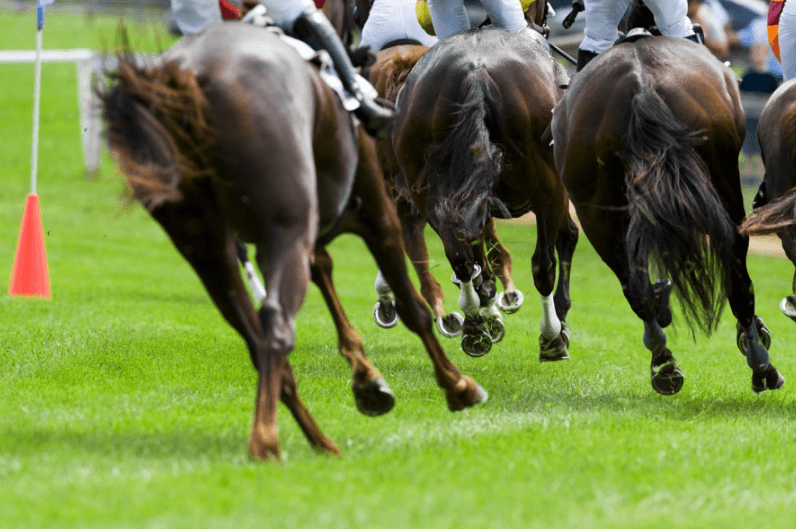Horse Racing and Its Environmental Impact: Can the Sport Go Green?

@ Instructions: This file is in a format called “markdown” (think of it as a raw output from ZimmWriter). Want a “pretty” output? Enable WordPress uploads, or enable HTML output in the ZimmWriter options menu. Alternatively, paste the contents below into https://markdowntohtml.com/ and then take the pretty output and paste it wherever you like, such as a Google Doc.
@ AI text and ancillary models used: GPT-4o Mini (OA). Estimate of about $0.00230 spent on about 452 words (Note: The estimate includes any Dall-E-3 image costs, but not any other image costs).
@ AI Status: The AI servers appear 100% healthy. Out of the 31 calls to the AI API server, 0 failed.
@ Settings used: Length=Tiny, Voice=Professional, Literary_Devices, Lists, Audience_Personality=Explorer, Custom_Style=Environmental Journalist, Automatic_Keywords, Use_H3, Active_Voice, Conclusion
@ Midjourney AI Image Prompt: /imagine prompt:A dynamic shot captures a vibrant horse racing scene, with sleek, muscular horses thundering down a lush green track, surrounded by a backdrop of rolling hills. Spectators, clad in bright colors, cheer enthusiastically, while eco-friendly banners flutter in the breeze. In the foreground, a patch of wildflowers contrasts with the pristine turf, symbolizing nature’s resilience. The sun casts a warm glow, illuminating the harmony between the thrill of the race and the call for environmental consciousness. –v 6 –ar 16:9
@ Meta Description: Can horse racing embrace sustainable practices to reduce its environmental footprint, or will it remain resistant to change? Discover the possibilities ahead.
The horse racing industry grapples with significant environmental challenges. From the maintenance of tracks to waste management, its ecological footprint is considerable. Yet, there exists potential for transformation. By adopting sustainable practices and innovative solutions, the sport could align with modern environmental values. However, the question remains: will horse racing embrace these changes, or will it continue to overlook its impact? The forthcoming discussion will explore the possibilities for a greener future in this traditional sport.
The Ecological Footprint of Horse Racing
The ecological footprint of horse racing is a multifaceted issue that warrants thorough examination.
Track maintenance requires significant resources, impacting local ecosystems through chemical usage and land alteration.
Additionally, horse transportation contributes to carbon emissions, raising concerns about sustainability.
Addressing these factors is essential for those who advocate for a greener future in the sport, highlighting the need for innovative, eco-friendly practices.
See also: powerturf
Waste Management Challenges in the Industry
Horse racing generates a substantial amount of waste, presenting significant management challenges that impact both the environment and public perception of the sport.
Key issues include:
- Inefficient manure disposal practices
- Limited waste recycling programs
- Contaminated runoff from waste storage
- Neglected treatment facilities
Addressing these challenges is essential for fostering a greener industry and enhancing the sport’s reputation among environmentally conscious audiences.
Sustainable Practices in Horse Racing
While the horse racing industry faces significant environmental scrutiny, a growing number of stakeholders are implementing sustainable practices that aim to mitigate its ecological footprint.
Initiatives include the use of organic feed to promote equine health while reducing chemical runoff.
Additionally, the development of eco-friendly facilities exemplifies a commitment to sustainability, encouraging a greener approach that aligns with the values of environmentally conscious stakeholders.
Future Innovations for a Greener Sport
As the horse racing industry navigates an era of heightened environmental awareness, innovative solutions are emerging that promise to reshape the sport for a greener future.
Potential advancements include:
- Integration of renewable energy sources for racetrack operations.
- Eco-friendly materials for race-day facilities.
- Sustainable waste management practices.
- Green transportation options for attendees.
These innovations could foster a more sustainable and liberated equestrian culture.
Conclusion
Ironically, while horse racing gallops towards thrilling finishes, it often leaves behind a trail of environmental concerns. Yet, the potential for a greener sport exists, as sustainable practices beckon like a finish line. By embracing eco-friendly initiatives, the industry could transform its image from one of reckless indulgence to a champion of sustainability. In this race against time, the true challenge lies not in the tracks, but in the commitment to a future where both horses and the planet thrive.





